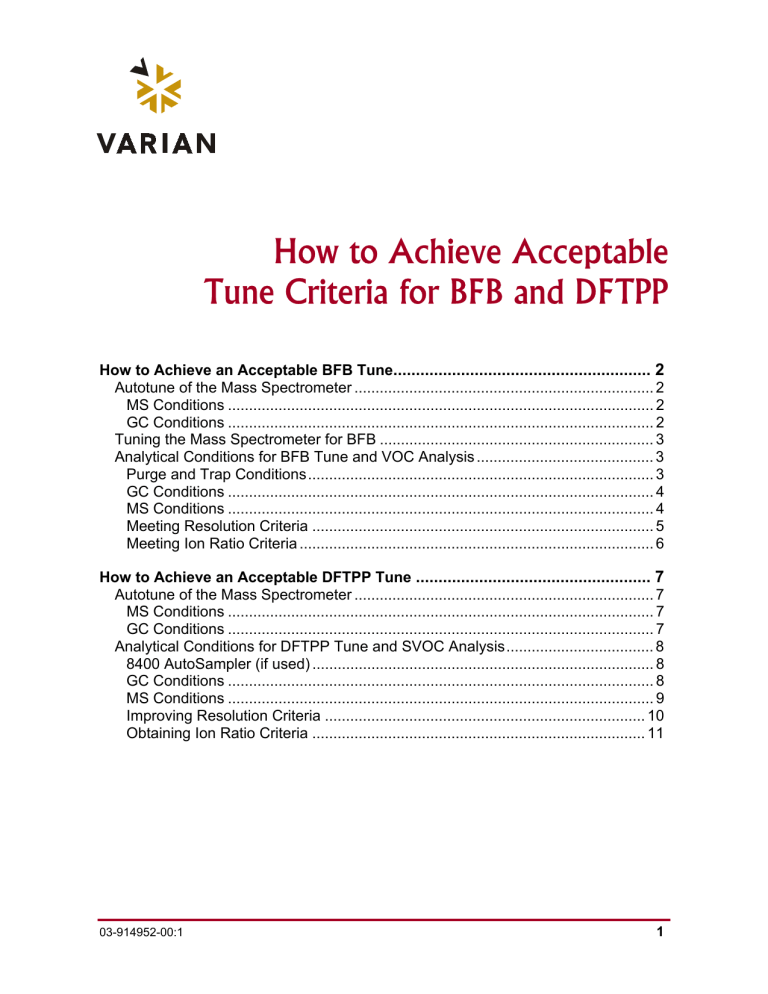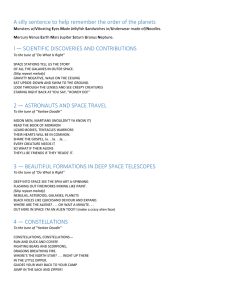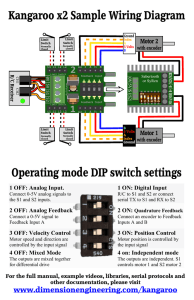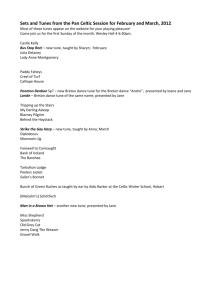
How to Achieve Acceptable Tune Criteria for BFB and DFTPP How to Achieve an Acceptable BFB Tune......................................................... 2 Autotune of the Mass Spectrometer ....................................................................... 2 MS Conditions ..................................................................................................... 2 GC Conditions ..................................................................................................... 2 Tuning the Mass Spectrometer for BFB ................................................................. 3 Analytical Conditions for BFB Tune and VOC Analysis .......................................... 3 Purge and Trap Conditions.................................................................................. 3 GC Conditions ..................................................................................................... 4 MS Conditions ..................................................................................................... 4 Meeting Resolution Criteria ................................................................................. 5 Meeting Ion Ratio Criteria .................................................................................... 6 How to Achieve an Acceptable DFTPP Tune .................................................... 7 Autotune of the Mass Spectrometer ....................................................................... 7 MS Conditions ..................................................................................................... 7 GC Conditions ..................................................................................................... 7 Analytical Conditions for DFTPP Tune and SVOC Analysis................................... 8 8400 AutoSampler (if used) ................................................................................. 8 GC Conditions ..................................................................................................... 8 MS Conditions ..................................................................................................... 9 Improving Resolution Criteria ............................................................................ 10 Obtaining Ion Ratio Criteria ............................................................................... 11 03-914952-00:1 1 How to Achieve an Acceptable BFB Tune To obtain EPA specified Tune criteria for BFB, the instrument conditions suggested in the Varian Environmental Manual (PN: 03-914895-00) need to be followed. Using these conditions will allow the generation of passing results most of the time; however occasional modifications may be necessary. A summary of the analytical conditions is described below. It is essential that the: Ion Trap temperature be set properly Column flow rate be set properly Autotune, particularly Mass calibration has been successfully performed under proper conditions (see details below) The MS acquisition method parameters are set as specified in the manual or as indicated below The suggested amount of BFB has been injected with the specified split rate Autotune of the Mass Spectrometer Before autotune can be performed reliably, certain basic conditions need to be established. MS Conditions Trap temp. Manifold temp. Transfer line temp. Electron multiplier Axial modulation 150 °C 60 °C 200 °C 10^5 Gain Setting 4.0V GC Conditions Flow/Pressure 1.2 mL/min (constant flow) Column oven 150 °C isothermal Perform autotune under these conditions. It will help to establish proper Electron Multiplier setting and mass calibration. The same conditions, with the exception of column temperature, will be used for BFB Tune and VOC analysis also. How to Achieve an Acceptable BFB Tune 2 Tuning the Mass Spectrometer for BFB The amount of BFB entering the ion trap should be 2-5 ng. If 1 µL BFB tune mix is introduced by syringe injection (split 1:20) the solution should be 50-125 ng/µL concentration. If the Purge and Trap apparatus introduces the BFB, the water sample concentration should be 2-5 ppb for 25 mL and 5-20 ppb for 5 mL sample volumes (split 1:20). Deviation from these levels will make it difficult to pass BFB tune requirements. Analytical Conditions for BFB Tune and VOC Analysis Purge and Trap Conditions 5 or 25 mL Purge Vessel VOCARB 4000 Trap 40 mL/min He Purge Flow Line temp. Valve temp. Mount temp. MCS line temp. Purge ready temp. 120 °C 130 °C 40 °C 120 °C 30 °C Sample heater Prepurge time Sample preheat time OFF 0.00 min 0.00 min Purge time Dry purge time MCS desorb temp. GC start option GC cycle time Cryo focuser Desorb preheat Desorb time. Desorb temp Sample drain Bake time Bake temp. Bake gas bypass MCM bake temp. Sample fill 11 min 0.0 min 40 °C start of desorb 35 min OFF 250 °C 4 min 250 °C ON 7 min 260 °C Off 250 °C 0.0 min How to Achieve an Acceptable BFB Tune 3 GC Conditions Type 5 EFC with split insert if 1177 or 1079 injectors are used. Direct connection of P&T transfer line to GC column if no injectors are connected. CP624 column, 60m x 0.32 mm 1.8 µm film (PN: CP7415) Injector Temperature (if present) 140 °C Split ratio Initial 20:1 3 min 50:1 4.1 min 20:1 Flow/Pressure 12 psi for 2 min 1.2 mL/min for 30 min Column Oven 35 °C hold 6 min 8 °C/min to 220 °C, hold 6 min, or until all compounds elutes (Follow this column programming if the BFB is introduced via the Purge and Trap system. Faster column oven ramping may cause the sudden coelution of the concentrated water vapor and hinder performance.) MS Conditions Parameters in Instrument Control Trap temp. Manifold temp. Transfer line temp. Electron multiplier Axial modulation 150 °C 60 °C 200 °C Autotune conditions 4.0V MS Acquisition Method Parameters Filament/multiplier delay VOC acquisition segment Mass range Ionization mode Ion preparation How to Achieve an Acceptable BFB Tune 3 min 3 min to 33 min 47-280 m/z EI Auto None 4 Segment Set Points Scan time Multiplier offset 0.7 second/scan 0V Emission current Count threshold Mass defect Cal gas 10 µA 1 0 Off (unchecked) Electron Ionization Mode Parameters Target 12000 counts Max ionization time 25000 µsec Prescan ionization time Background mass RF dump value 100 µsec 45 m/z 650 m/z Low Mass (m/z) High Mass (m/z) Ionization Storage Level (m/z) Ionization Time factor (%) 1 10 70 35 120 2 71 78 35 70 3 79 150 35 100 4 151 650 35 70 The BFB peak will be checked by EnviroPro software (PN: 03-930359-91) or by the Custom Reports software included in the Saturn WS software for BFB Tune criteria. The tune may be checked on a single scan or on the average of 3 or 5 scans. Use background correction when checking for acceptance criteria. The tune maybe checked on the spectrum at the apex of the peak (retention time), or at any time (not necessarily at the apex) as entered by the user. If the tune criteria are not met while using the suggested parameters, additional adjustment may be necessary to meet EPA tune requirements: Meeting Resolution Criteria If the resolution criteria for ions 96, 173, 175, 176, 177 are not met, the most common reason is that the multiplier voltage is set too low for the required mass spectral resolution. Increase the multiplier voltage by 50-100V and repeat the injection. How to Achieve an Acceptable BFB Tune 5 Lower than optimum multiplier voltage will decrease the resolution of neighboring ions, resulting in the specified ratios exceeding the requirements. This may happen even if the multiplier voltage was set recently by autotune. Increasing the multiplier voltage by 50-100V will not have adverse effects. Adjusting AM Voltage: The default AM voltage is 4.0V in the system. The adjustment (± 1V in decimal increments) of this voltage also will help to achieve the required ion ratio criteria. NOTE: If the AM voltage is changed, verify that the resolution of ions 131/132 does not deteriorate. This can be viewed by turning on the cal gas and monitoring the spectrum in manual page of system control of the Saturn module. A new mass calibration must be carried out to maintain correct mass assignment if the AM voltage has been changed. Improved resolution can also be achieved by lowering the AGC Target value. The suggested target will give a good starting point, but it may be lowered by 1000-2000 count. Meeting Ion Ratio Criteria The ion ratios specified in the EPA (particularly the older) methods are based on data collected on older generation instruments with poor detection efficiencies for the higher mass ions. To achieve the required criteria, increase/decrease the ionization time factor to achieve the proper ratios. Increasing the ion time will increase the ion intensity of the ions in that segment. Once intensity ratios for the major BFB ions at m/z 50, 75, 95, and 174 have been adjusted, the ion time factors rarely need to be readjusted. How to Achieve an Acceptable BFB Tune 6 How to Achieve an Acceptable DFTPP Tune To obtain EPA specified Tune criteria for DFTPP, instrument conditions suggested in the Varian Environmental Manual (PN: 03-914895-00) need to be followed. Using these conditions will allow the generation of passing results most of the time; however, occasional modifications may be necessary. A summary of the analytical conditions is described below. It is essential that the: Trap temperature be set properly Column flow rate be set properly Autotune, particularly Mass calibration has been successfully performed under proper conditions (see details below) The MS acquisition method parameters be set as specified in the manual or as indicated below The suggested amount of DFTPP has been injected. (If DFTPP is not stored properly, it will decompose. Make sure fresh standard is used for DFTPP tune testing.) Autotune of the Mass Spectrometer Before reliable autotune can be performed, basic conditions need to be established. MS Conditions Trap temp. 220 °C Manifold temp. 50 °C Transfer line temp. Electron multiplier Axial modulation 280 °C 10^5 Gain Setting 4.0V GC Conditions Flow/Pressure 1.2 mL/min (constant flow) Column oven 200 °C, isotherm Perform autotune under these conditions. It will help to establish proper Electron Multiplier setting and mass calibration. These will be the conditions for Tune / SVOC analysis also. How to Achieve an Acceptable DFTPP Tune 7 Amount of DFTPP The amount of DFTPP entering the ion trap should be 5 ng or less. If only higher concentration mixture is available, such as 50 ng/µL, use a 1 µL split injection at 10:1 split or dilute the STD. If more than 5 ng DFTPP enters the ion trap, it will be difficult to meet DFTPP tune requirements. Analytical Conditions for DFTPP Tune and SVOC Analysis 8400 AutoSampler (if used) Syringe Size: Injection Mode: Solvent Penetration Depth: Sample Penetration Depth: 10 µL STD Split/Splitless 90% 95% Default Clean Vial; I (solvent Ethylacetate) Default Clean Volume: 7.0 µL Default Clean Strokes: 1 Default Clean Drawup Speed: 5.0 µL/sec Clean Mode Pre-Inj. Solvent Flushes: Clean Mode Post –Inj Solvent Flushes: Clean Mode Pre-Inj Sample Flushes: Clean Mode Solvent Source: 1 3 0 I GC Conditions Type 1 EFC with 4 mm split Siltek frit insert (PN: RT210462145) for the 1177 injector, CP Sil8 MS low bleed column, 30m x 0.25 mm 0.25µ film (PN: CP5860) Septum Purge Flow: 4 mL/min at 45 psi Injector Temperature 280 °C Splitless injection (1 µL of 5 ng/µL std) Splitter programming Initial ON 20:1 split 0.01 min OFF (use the appropriate split ratio for higher concentration of DFTPP) 0.75 min ON 20:1 split How to Achieve an Acceptable DFTPP Tune 8 EFC Flow/Pressure Pressure Pulse is used for optimum sample introduction. Pressure pulse: 45 psi Pressure Pulse duration: 0.85 min. Constant Column flow: 1.2 mL/min (following the pressure pulse, starts at 0.85 min to the end of the run) NOTE: Do not perform air/water test or mass calibration under pressure pulse conditions. The MS internal parameters are set for 1.0 mL/min (normal analytical conditions) to deliver reliable results for these operations. During the pressure pulse the column flow is much higher and will result inaccurate readings. Column Oven 70 °C, hold 1.5 min 10 °C/min to 200 °C, no hold 15 °C /min to 300 °C, hold 10 min The column oven temperature program may be altered to gain DFTTP results faster. MS Conditions MS Acquisition Parameters Filament/Multiplier Delay Acquisition Segment Mass Range Ionization Mode Ion Preparation 2.0 min 2 min to 40 min 45-450 m/z EI Auto None Segment Setpoints Scan Time Multiplier Offset 0.9 second/scan 0-100 volt (100V multiplier offset increases the spectral resolution for DFTPP and also increases sensitivity) Emission Current Count Threshold Mass Defect Cal Gas 10 µA 2 0 Off (Unchecked) How to Achieve an Acceptable DFTPP Tune 9 Electron Ionization Mode Parameters Target: 8000 counts Max Ionization Time: 25000 µsec Prescan ionization Time: 100 µsec Background mass: 45 m/z RF Dump value: 650 m/z Low Mass (m/z) High Mass (m/z) Ionization Storage Level (m/z) Ionization Time factor (%) 1 10 75 37 120 2 76 130 37 240 3 131 270 37 90 4 271 332 37 45 5 333 399 37 70 6 400 650 37 22 The DFTPP peak will be checked by EnviroPro software (PN: 03-930359-91) or with the Custom Reports software included in the Saturn WS software for the DFTPP Tune criteria. The tune may be checked on a single scan or on the average of 3 or 5 scans. Use background correction when checking the tune criteria. The tune maybe checked on the spectrum at the apex of the peak (retention time), or at any time (not necessarily at the apex) as entered by the user. If the tune criteria are not met while using the suggested parameters, additional adjustment may be necessary to meet EPA tune requirements: Improving Resolution Criteria If the resolution criteria of ions 68, 70, 197, 199, 441, 443 are not met, the most common reason is that the multiplier voltage needs to be increased. Increase the multiplier voltage by 50-100V and repeat the injection. A lower than optimum multiplier voltage will decrease the resolution of neighboring ions; resolution ions ratios then are higher than specified. This may happen even if the multiplier voltage was set recently by autotune. Increasing the multiplier voltage by 50-100V will not have adverse effects. How to Achieve an Acceptable DFTPP Tune 10 Adjusting AM voltage: The default AM voltage is 4.0V in the system. The adjustment (± 1V in decimal increments) of this voltage also will help to achieve the required ion ratio criteria. NOTE: If the AM voltage is changed, verify that the resolution of ions 131/132 did not deteriorate. This can be viewed by turning on the cal gas and monitoring the spectrum in Manual Control page of System Control for the Saturn MS module. A new mass calibration must be carried out to maintain correct mass assignment if the AM voltage has been changed. Inject less DFTPP, about 2-3 ng on-column. (Improved resolution can be achieved by lowering the Target value. The suggested target will give a good starting point, but it may be lowered by 1000-2000 count.) Obtaining Ion Ratio Criteria The ion ratios specified in the older EPA methods are based on data collected on older generation instruments with poor detection efficiencies for the higher mass ions. To achieve the required criteria, increase or decrease the ionization time factor to achieve the proper ratios. Increasing the ion time will increase the ion intensity of the ions in the selected segment. Once ion time factors have been set well, they rarely need readjustment. How to Achieve an Acceptable DFTPP Tune 11





